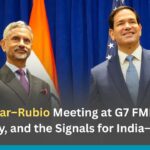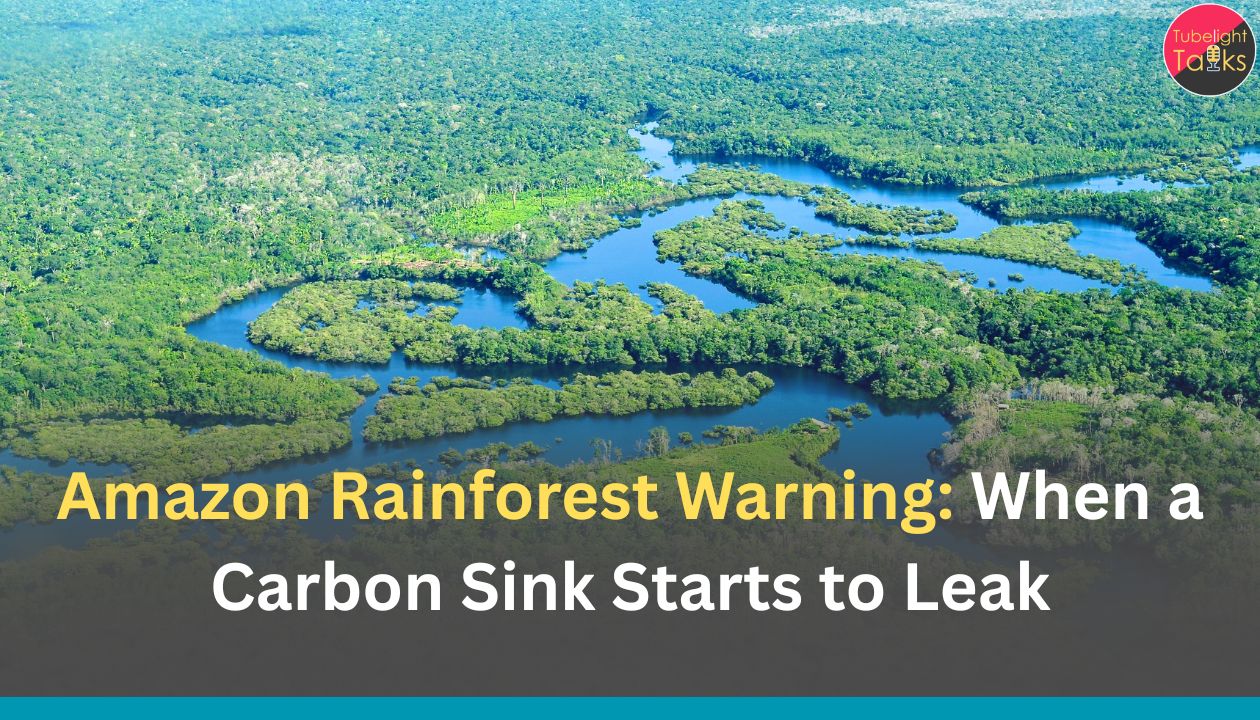Jaishankar-Rubio Meeting at G7: On the sidelines of the G7 Foreign Ministers’ Meeting (FMM) in Niagara, Ontario, External Affairs Minister Dr S. Jaishankar met US Secretary of State Marco Rubio for a focused conversation on trade, supply chains, and current global flashpoints. In his official post, Jaishankar recorded thanks for Rubio’s condolences on the Delhi Red Fort blast and flagged consultations on Ukraine, West Asia/Middle East, and the Indo-Pacific.
The meeting came as India joined G7 Outreach sessions on energy security and critical minerals, with the MEA and Global Affairs Canada publishing event details and ministerial bilaterals. Here’s the context, the agenda, and what to watch next.
Straight From the Dr Jaishankar X Post
The post that set today’s agenda:
“Good to meet @SecRubio this morning at #G7 FMM. Appreciate his condolences on the loss of lives in the blast in Delhi. Discussed our bilateral ties, focusing on trade and supply chains. Exchanged views on the Ukraine conflict, the Middle East/West Asia situation and Indo-Pacific.” — Dr S. Jaishankar
Where and Why They Met: The G7 Backdrop
India was invited to the G7 Foreign Ministers’ Meeting with Outreach Partners hosted by Canada. The MEA announced Jaishankar’s participation (Nov 11–13), including an Outreach Session on Energy Security and Critical Minerals—an area where India and the US have launched deeper cooperation to de-risk supply chains.
Canada’s official briefings and readouts around the G7 FMM also confirm Niagara, Ontario as the venue, with multiple bilaterals held at the margins—including meetings involving Secretary Rubio, underscoring the dense diplomatic traffic of the day.
The US Counterpart: Who Rubio Is, and Why That Matters
Marco Rubio is the US Secretary of State, confirmed by the Senate in January 2025. His portfolio and public positions emphasize strategic competition with China, support for Israel, and supply-chain realignments—all relevant to India–US coordination. Understanding the US interlocutor helps decode the policy tilt of the conversation.
The Agenda Pillars
Trade and Supply Chains
Why it’s the first line of the readout
Both sides have prioritised resilient, trusted supply chains—from semiconductors and telecom to critical minerals (lithium, cobalt, graphite, rare earths). With India expanding domestic capacity and the US anchoring “friend-shoring,” G7 week was an apt place to compare notes. The G7 Outreach focus on energy security & critical minerals directly dovetails with India–US initiatives to diversify sourcing, processing, and downstream manufacturing.
What “trade + supply chains” likely covered
- Critical minerals: aligning geological data rooms, investment norms, and environmental safeguards for projects that can feed EVs and renewables.
- Tech hardware: facilitating components and final assembly footprints in India; reducing single-country risk in upstream inputs.
- Customs & standards: making it easier for small & mid-size suppliers to qualify in cross-border value chains—testing, certification, and digital trade rails.
Security Conversations: Ukraine, West Asia, Indo-Pacific
Ukraine
India and the US routinely compare assessments on battlefield dynamics, energy shocks, and grain corridors. The G7 setting provides updated briefings and coordination points even for non-G7 partners. (This line follows from the minister’s post that Ukraine was discussed.)
West Asia/Middle East
West Asia’s volatility Gaza conflict aftershocks, Lebanon–Israel exchanges, and maritime risks in the Red Sea feeds directly into energy prices and shipping insurance. India balances diaspora safety, energy security, and principled positions; the US weighs alliance dynamics. A G7 margins huddle is where working understandings are clarified. (Backdrop per routine G7 discussions; specific quotes per Jaishankar’s post.)
Indo-Pacific
From South China Sea risks to technology norms, the Indo-Pacific remains the structural frame of India–US coordination. With Washington’s current focus on strategic competition and New Delhi’s focus on multi-alignment and capacity-building, “Indo-Pacific” serves as a shorthand for multiple lines: maritime domain awareness, defence logistics, technology standards, and supply-chain mapping.
The Delhi Blast: Condolences and International Reactions
Jaishankar’s post explicitly notes Rubio’s condolences over the Red Fort car blast in Delhi. In the last 48 hours, US readouts and multiple outlets quoted Secretary Rubio calling the incident “clearly a terrorist attack,” while praising India’s measured and professional investigation. The death toll has risen in successive updates; Delhi Police have invoked anti-terror provisions as the probe advances.
This moment inevitably colours diplomatic conversations: counter-terrorism cooperation, intel sharing, and technology support for forensics and surveillance typically surge into view after such attacks.
Why This Meeting Matters Now
Economic Security Is Strategic Security
From chips to cathodes
Trade and supply chains are not merely commercial topics. In 2025, chips, batteries, and mineral inputs underpin power balances. India–US conversations aim to mitigate single-point failures—a lesson from the pandemic and recent export controls worldwide. The G7 lens encourages convergence on standards, traceability, and financing to stand up new capacity.
The People Factor—Condolences That Carry Policy Weight
Counter-terror cooperation
Public condolences, especially at ministerial level, help set the tone for operational cooperation—joint training, watch-list interoperability, and crisis communication. Rubio’s on-camera remarks that India is handling the probe “professionally” and doesn’t need outside help underscore trust and respect, while keeping doors open for assistance if requested.
Multipolar Diplomacy, G7 Edition
Outreach as a bridge
India’s participation at G7 Outreach meetings has become a steady feature of major gatherings. The format lets New Delhi advance interests—energy access, critical minerals, trade facilitation—without being a formal G7 member, and compare notes with Western partners amidst ongoing friction with Beijing and Moscow.
Reading Between the Lines: Likely Deliverables and Watch-Fors
Trade & Tech
Standards and testing
Expect follow-ups on mutual recognition or pilot testing hubs that shorten supplier onboarding for Indian firms entering US-bound value chains.
Critical-minerals finance
G7/US development finance tools (DFC-style instruments) could back Indian or third-country projects that feed Indian processors, especially where the US seeks non-Chinese offtake.
Security & Geo-Economics
Maritime coordination
More maritime domain awareness sharing in the Indian Ocean, factoring in Houthi-linked threats in sea lanes and spillovers from West Asia.
Ukraine policy space
While India keeps strategic autonomy, regular briefings can maintain a minimum viable alignment on energy and sanctions management to avoid unintended frictions.
A Quiet Ethic for Hard Times
Moments like a high-stakes G7 or a nation’s grief after an attack invite a quieter question: What values guide our choices? In Sant Rampal Ji Maharaj spiritual traditions, virtues such as truthfulness, non-harm, self-discipline, and service are seen as practical tools, not abstractions. In diplomacy and public life, that ethic can look like honest communication, restraint in the use of power, protection of innocents, and duty towards the wider community.
For those who wish to explore this lens further, consider resources that distill these principles for everyday life and civic responsibility including teachings and talks that emphasise scripture-aligned conduct and seva (selfless service). (Official resources: jagatgururampalji.org; YouTube channel; verified X handle.)
Read Also: India–US Relations in 2025: Navigating Strategic Partnership Amid Rising Trade Tensions
FAQs: Dr Jaishankar-Rubio Meeting at G7
1) What exactly did Jaishankar say about the meeting?
He thanked Secretary Rubio for condolences on the Delhi blast, and said they discussed trade & supply chains and exchanged views on Ukraine, West Asia, and the Indo-Pacific. (See his X post.)
2) Was this on the margins of a bigger event?
Yes—on the sidelines of the G7 Foreign Ministers’ Meeting in Niagara, Ontario, where India participated in Outreach sessions on energy security and critical minerals.
3) Is Marco Rubio currently the US Secretary of State?
Yes. He was confirmed by the US Senate in January 2025.
4) What did Rubio say about the Delhi blast?
He called it “clearly a terrorist attack,” praised India’s professional handling of the probe, and conveyed solidarity—remarks widely reported by Indian and global media.
5) Why are critical minerals mentioned so often?
Because the G7 Outreach session included energy security and critical minerals—a core area where India and the US want resilient, reliable supply chains and less geographic concentration risk.










